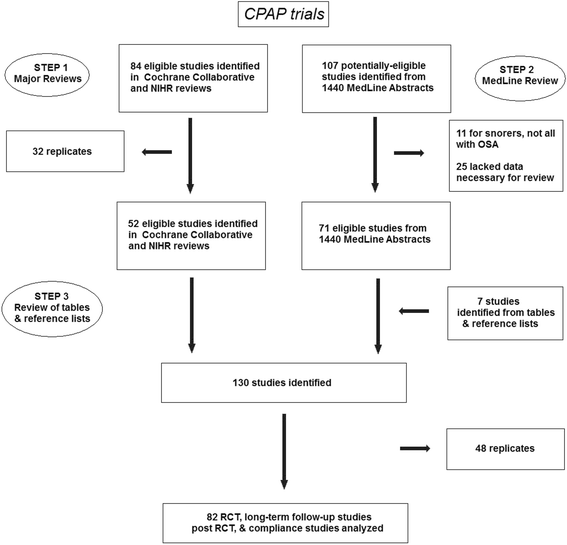Reconsidering first-line treatment for obstructive sleep apnea: a systematic review of the literature
- PMID: 27048606
- PMCID: PMC4822285
- DOI: 10.1186/s40463-016-0136-4
Reconsidering first-line treatment for obstructive sleep apnea: a systematic review of the literature
Abstract
Background: Continuous positive airway pressure (CPAP) is typically recommended as first line therapy for obstructive sleep apnea, but the adherence rate of CPAP is problematic. This study's objective was to systematically review the literature relating to CPAP as first line therapy for OSA and compare it to surgical literature on the same topic.
Methods: A systematic review was conducted according to PRISMA guidelines, examining Medline-Ovid, Embase, and Pubmed databases. The primary search objective was to identify all papers reporting the results of (1) randomized clinical trials (RCT) of CPAP for the treatment of adults with OSA; and (2) both randomized and non-randomized clinical trials and case series on the surgical treatment of OSA in adults. A PhD-level biostatistician first screened papers, and then those that met study criteria were retrieved and analyzed using standardized forms for each author. The primary outcomes were adherence rates of CPAP.
Results: A total of 82 controlled clinical trials for CPAP and 69 controlled and non-controlled surgery trials were identified for analysis. Variation in CPAP use within reported RCT trials were identified, and the majority of patients in the studies would eventually be considered non-adherent to CPAP.
Conclusions: When considering the numerous patient-related factors that come into play when CPAP is prescribed, the concept of CPAP as gold-standard therapy for OSA should be reconsidered. In many cases surgery can provide a better overall outcome. This study's results suggest that certain patients with OSA may be managed more effectively with surgery than CPAP, without confounding issues of treatment adherence.
Keywords: CPAP; Obstructive sleep apnea; Uvulopalatoplasty.
Figures
References
-
- Giles TL, Lasserson TJ, Smith B, White J, Wright JJ, Cates CJ. Continuous positive airways pressure for obstructive sleep apnoea in adults: a Cochrane Collaboration Review. Etobicoke, Canada: John Wiley & Sons, Ltd; 2008. Issue 4, 1–103.
-
- McDaid C, Griffin S, Weatherly H, et al. Continuous positive airway pressure devices for the treatment of obstructive sleep apnoea-hypopnoea syndrome: a systematic review and economic analysis. Southampton, UK: National Institutes of Health Research Health Technology Assessment Program; 2009.1–162. - PubMed
-
- Sundaram S, Lim J, Lasserson TJ. Surgery for obstructive sleep apnoea in adults: A Cochrane Collaboration Review. Etobicoke, Canada: John Wiley & Sons, Ltd; 2009. 1, 1–72.
Publication types
MeSH terms
LinkOut - more resources
Full Text Sources
Other Literature Sources
Medical
Miscellaneous



